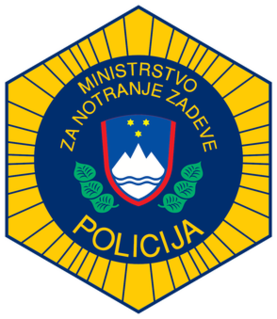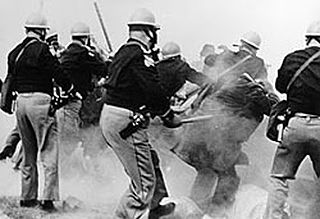Related Research Articles

A police officer, also known as a policeman or policewoman, is a warranted law employee of a police force. In most countries, "police officer" is a generic term not specifying a particular rank. In some, the use of the rank "officer" is legally reserved for military personnel.

The use of force, in the context of law enforcement, may be defined as the "amount of effort required by police to compel compliance by an unwilling subject".

The United States Department of Veterans Affairs Police is the uniformed law enforcement service of the U.S. Department of Veterans Affairs, responsible for the protection of the VA Medical Centers (VAMC) and other facilities such as Outpatient Clinics (OPC) and Community Based Outpatient Clinics (CBOC) operated by United States Department of Veterans Affairs and its subsidiary components of the Veterans Health Administration (VHA) as well as the National Cemetery Administration (NCA) and the Veterans Benefits Administration (VBA) respectively. The VA Police have several divisions and operate separately but alongside the VA Law Enforcement Training Center under the umbrella of the Office of Security and Law Enforcement. The primary role of VA Police is to serve as a protective uniformed police force in order to deter and prevent crime, maintain order, and investigate crimes which may have occurred within the jurisdiction of the Department or its federal assets. Some cases are investigated in conjunction with Special Agents from the Office of the Inspector General.
The Corporate Equality Index is a report published by the Human Rights Campaign Foundation as a tool to rate American businesses on their treatment of gay, lesbian, bisexual and transgender employees, consumers and investors. Its primary source of data are surveys but researchers cross-check business policy and their implications for LGBT workers and public records independently. The index has been published annually since 2002. Additionally, the CEI focuses on the positive associations of equality promoting policies and LGBT supporting businesses which has developed to reflect a positive correlation between the promotion of LGBT equality and successful organizations. Following the top 100 corporations that are publicly ranked under the CEI, participating organizations remain anonymous. For businesses looking to enforce and expand LGBT diverse and inclusive policies, the CEI provides a framework that allows businesses to recognize and address issues and policies that restrict equality for LGBT people in the workplace.
Law enforcement in the United States is one of three major components of the criminal justice system of the United States, along with courts and corrections. Although each component operates semi-independently, the three collectively form a chain leading from an investigation of suspected criminal activity to the administration of criminal punishment.
Law enforcement in Pakistan is one of the three main components of the criminal justice system of Pakistan, alongside the judiciary and the prisons. The country has a mix of federal, provincial and territorial police forces with both general and specialised functions, but the senior ranks of all the provincial forces and most of the federal ones are manned by members of the Police Service of Pakistan (PSP). The PSP is one of the most prestigious parts of the Central Superior Services, Pakistan's main civil service organisation. Federal law enforcement agencies are generally overseen by the Ministry of Interior of the Government of Pakistan, while provincial police forces are overseen by a department of the government of that province.

The Slovenian National Police Force is the national government agency that handles the responsibility of law enforcement of the Republic of Slovenia. It is composed of the eight police directorates in Celje, Koper, Kranj, Ljubljana, Maribor, Murska Sobota, Nova Gorica, and Novo Mesto. Law enforcement in Slovenia is governed by the Slovenian Ministry of Internal Affairs. The police force maintains a number of international partnerships with foreign police forces, including training with the U.S. Federal Bureau of Investigation, and involvement in Albania and Kosovo with the Multinational Advisory Police Element. The Slovenian police force was admitted to Organization for Security and Co-operation in Europe on March 24, 1992.
The business case for diversity stems from the progression of the models of diversity within the workplace since the 1960s. In the United States, the original model for diversity was situated around affirmative action drawing from equal opportunity employment objectives implemented in the Civil Rights Act of 1964. Equal employment opportunity was centered around the idea that any individual academically or physically qualified for a specific job could strive for at obtaining the said job without being discriminated against based on identity. This compliance-based model gave rise to the idea that tokenism was the reason an individual was hired into a company when they differed from the dominant group. Dissatisfaction from minority groups eventually altered and/or raised the desire to achieve perfect employment opportunities in every job.
Police accountability involves holding both individual police officers, as well as law enforcement agencies responsible for effectively delivering basic services of crime control and maintaining order, while treating individuals fairly and within the bounds of law. Police are expected to uphold laws, regarding due process, search and seizure, arrests, discrimination, as well as other laws relating to equal employment, sexual harassment, etc. Holding police accountable is important for maintaining the public's "faith in the system". Research has shown that the public prefers independent review of complaints against law enforcement, rather than relying on police departments to conduct internal investigations. There is a suggestion that such oversight would improve the public's view on the way in which police officers are held accountable.
The federal government of the United States empowers a wide range of law enforcement agencies to maintain law and public order related to matters affecting the country as a whole.
Cultural sensitivity, also sometimes referred to as cross-cultural sensitivity or simply cultural awareness, is the knowledge, awareness, and acceptance of other cultures and others' cultural identities. It is related to cultural competence, and sometimes regarded as the precursor to the achievement of cultural competence, but is a more widely used term than cultural competence. On the individual level, cultural sensitivity enables travellers and workers to successfully navigate a different culture with which they are interacting.

Proactive policing is the practice of deterring criminal activity by showing police presence. It includes activities such as the use of police powers by both uniformed and plain-clothes officers, engaging the public to learn their concerns, and investigating and discovering offences and conspiracies to commit crimes so that the crimes cannot be committed. In contrast, responding to a complaint after a crime has been committed is reactive policing.

Police brutality is the repression by personnel affiliated with law enforcement when dealing with suspects and civilians. The term is also applied to abuses by "corrections" personnel in municipal, state, and federal prison camps, including military prisons.
The concept of multicultural and diversity management encompasses acceptance and respect, recognition and valuing of individual differences. Diversity is defined as differences between people, that can include dimensions of race, ethnicity, gender, sexual orientation, socioeconomic status, age, physical abilities, religious beliefs, political beliefs, or other ideologies. Multiculturalism refers to the existence of linguistically, culturally and ethnically diverse segments in an organisation.
Gender diversity is equitable or fair representation of people of different genders. It most commonly refers to an equitable ratio of men and women, but may also include people of non-binary genders. Gender diversity on corporate boards has been widely discussed, and many ongoing initiatives study and promote gender diversity in fields traditionally dominated by men, including computing, engineering, medicine, and science It is argued that some proposed explanations are without merit and are in fact dangerous, while others do play a part in a complex interaction of factors. It is suggested that the very nature of science may contribute to the removal of women from the ‘pipeline’.
The history of law enforcement in the United States includes many efforts at police reform. Early efforts at police reform often involved external commissions, such as the Wickersham Commission, that spelled out reforms but left to the police to implement them, often with limited success.
Women in policing in the United States, colloquially known as women police or female cop, began as early as the 1890s. Women make up 12.6% of all U.S. sworn police officers in 2018. Employed largely as prison matrons in the 19th century, women took on more and increasingly diverse roles in the latter half of the 20th century. They face a particular set of challenges given the history of their entry into the profession, their low rates of participation, and the complex identities they negotiate in the work place. Women who work in law enforcement have struggled for years to gain acceptance in their workplace. Some of their biggest challenges are their lack of representation, stereotypes around women, and intersectionality.

In policing equipment, a body camera or wearable camera, also known as body worn video (BWV) or body-worn camera (BWC) or Bodycam, is a wearable audio, video, or photographic recording system used to record events in which law enforcement officers are involved. They are typically worn on the torso of the body on the officer's uniform. Body worn cameras for policing are often similar to other body worn video equipment used by civilians, firefighters, or the military, but are designed to address specific requirements related to law enforcement.
A civilian police oversight agency, also known as citizen review board or civilian review board, is a body of civilians in an American city that is tasked with reviewing and improving police officer conduct.
References
- ↑ Ba, Bocar A.; Knox, Dean; Mummolo, Jonathan; Rivera, Roman (2021-02-12). "The role of officer race and gender in police-civilian interactions in Chicago". Science. 371 (6530): 696–702. doi:10.1126/science.abd8694. ISSN 0036-8075. PMID 33574207. S2CID 231884657.
- ↑ Richardson, Glover, D.M, J.G. "Total Approach to Diversity An Assessment and Curriculum Guide for State Courts Model Guide 1". Bureau of Justice Assistance (BJA). 95-DD-BX-0010: 31–120 – via Office of Justice Programs; U.S Department of Justice.
- ↑ "Police Officers Explain Why Diversity in Law Enforcement Matters | Rasmussen University". www.rasmussen.edu. Retrieved 2021-03-01.
- ↑ "Diversity Training for Law Enforcement and Police". The Ceceilyn Miller Institute. 2016-09-01. Retrieved 2021-03-01.
- ↑ "Diversity in Policing". online.wlu.ca. Wilfrid Laurier University. August 25, 2016. Retrieved 2021-03-01.